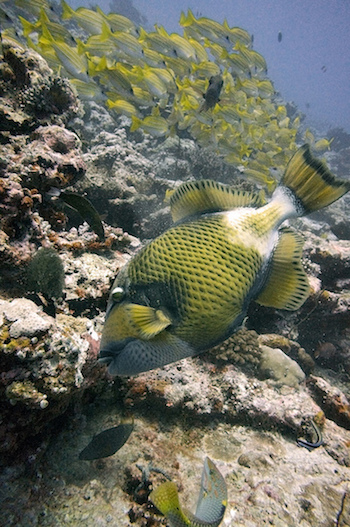- While smaller fish with short life spans tend to rebound quickly in protected reefs, larger, longer-lived fish may need more than 100 years of strong protection to fully recover, a new study concludes.
- For the new study, researchers analyzed fish survey data from 324 coral reef sites in the Indian Ocean, spanning eight countries.
- The researchers found that the recovery process in large, well protected marine reserves was faster than in smaller, poorly protected reserves, where they predicted that fish communities would never fully recover from overfishing.
Reef fish may take longer to recover from overfishing than previously thought. While smaller fish with short life spans tend to rebound quickly in protected reefs, larger, slow growing fish may need more than 100 years of strong protection to fully recover, a new study concludes.
The study was published online this month in the journal Proceedings of the Royal Society B. Tim McClanahan, senior conservationist for the Wildlife Conservation Society, and Nick Graham, a researcher with James Cook University in Australia, analyzed fish survey data from 324 coral reef sites in the Indian Ocean, spanning eight countries. They classified the study sites into six management categories ranging from large, uninhabited, remote protected areas down to reefs open to fishing with no restrictions on gear, which included destructive dragnets and explosives.
For the fish at each site, the researchers evaluated family-level life history characteristics, such as body length, growth rate, age of maturation, and mortality. Previous research into reef-fish recovery rates primarily investigated biomass — the collective weight of fish in a given area — and tended to conclude that fish communities in protected reefs had recovered when their biomass leveled off, often after about 20 years. But many life-history metrics of a reef community continue to change for decades after biomass levels off, the study found, and the full recovery process may take over a century.

“Fish biomass has been the common way to evaluate fish communities, but what our research shows is that it does not tell the entire story,” McClanahan said in a statement.
“Analyses based primarily on fish biomass produces [sic] an incomplete and somewhat misleading scenario for fast recovery from overfishing. What we found was a slow and continuous reorganization of the fish community well past the stabilization of biomass,” he said.

The distinction between calculating reef-fish recovery rates based on biomass versus life history metrics is only one aspect of the study with potential implications for fisheries management and coral reef conservation. In its evaluation of reef-fish recovery rates, the study also distinguished between protected reef areas by size, age, and level of protection.

Three of the six management categories that the researchers divided their 324 study sites into comprised protected reef areas. The first category, which served as the baseline system for the study, consisted of 36 sites in the massive, uninhabited, remote protected area of the Chagos Marine Reserve, part of the British Indian Ocean Territory. The second category was for high-compliance marine reserves. And the third category of protected reefs was for young and low-compliance marine reserves, including those without regular or effective patrols or enforcement.
“Categorizing management effectiveness helped to tease apart the various influences and led to a better understanding of how fishing changes the life histories of fish communities,” the researchers write in the study. The findings of the new study “would not have been evident unless high compliance closures were present in the region and evaluated separately from low compliance closures,” they write.
Coral reef fish communities recover even more slowly and less completely in low-compliance and young marine reserves than in high-compliance reserves, they found. While they expect that the recovery process in high-compliance reserves would take more than 100 years, they predicted that life-history metrics for reef fish in low-compliance reserves would never reach pre-fishing levels.
The age of marine protected areas clearly plays a role in reef fish recovery, but so does size. Reserves should be at least five to 10 square kilometers, according to the study. “Reducing closure size slowed recovery rates, particularly in the low compliance and young closures,” the study states. Reef fish that do not recover well in small, new, or low-compliance reserves include parrotfish, triggerfish, and groupers.

“The effective protection of the full suite of fish species and life history characteristics will depend on the establishment of large reserves with strict enforcement,” Graham said in the statement.
The study findings come at a critical time, just past the halfway point between 2010, when governments around the world committed to protecting 10 percent of the oceans under the Convention on Biological Diversity, and 2020, when they are to meet that goal. As of late 2015, only 3.6 percent of the planet’s oceans were protected in some way — and significant commercial fishing is permitted in a full half of that area.
Citations
- McClanahan, T.R., Graham, N.A.J. (2015). Marine reserve recovery rates towards a baseline are slower for reef fish community life histories than biomass. Proceedings of the Royal Society B 282: 20151938.